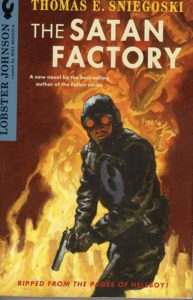Book Review: Lobster Johnson: The Satan Factory by Thomas E. Sniegoski
Disgraced doctor Jonas Chapel, on the run from the mob in Mexico, stumbles across a mysterious skeleton dripping a fluid that turns humans into monsters. Soon thereafter Chapel’s back in New York, teaming up with the very gang boss who’d ordered the hit on him to take over all the gangs in the city. Or so mobster Rocco Fazzina thinks, but Dr. Chapel’s ambitions are larger than that. Only the masked man known as the Lobster and his few agents are aware of the Satan Factory and the threat it poses to all human life!
The Lobster is a character first appearing in the Hellboy comic books by Mike Mignola. He was a vigilante of the 1930s, dead in the present day, and had become known at “Lobster Johnson” through a series of ever less accurate fictionalizations. For the purposes of this book, the body of the story is a previously unknown manuscript that predates all other fictionalizations, and may have been written by an agent of the Lobster himself.
That agent (under the alias Jacob Hurley) is a former police officer who’d been framed for corruption when he dared speak out against it, and after several years in prison, released to become an unemployable homeless man. He’s recently been recruited by the Lobster to keep an eye on the city’s underbelly. As this is the twilight period of history after the start of the Depression but before the end of Prohibition, there is a thriving Hooverville for Jake to get information from.
As a new agent of the Lobster, Jake serves as the viewpoint character to introduce us to the team. We also get scenes from the viewpoint of the Lobster, but these are all directly connected to his fight against crime and tell almost nothing about his personal life beyond dark allusions to tragic events that motivated him to become the Lobster, and perhaps gave him his “not a normal human” status.
The Lobster is much in the Spider mode, branding fallen foes with his lobster claw emblem, and killing scores of monsters as well as any gangster that crosses his path (that isn’t killed by something else.)
We get a bit more insight into the backgrounds of villains Chapel and Fazzina, and how they got started on their paths to darkness. By the end, however, there’s almost nothing left of Dr. Chapel’s original personality as the owner of the skeleton starts taking him over to spread its army of monsters.
This book is very much is the pulp tradition with lots of fast moving action and not much time spent on introspection. Also in the pulp tradition, there’s a glitch–as I hinted at above, “Lobster Johnson” was a name attached to the Lobster only much later than the purported date of the manuscript, and yet the narrative slips and calls him that a couple of times.
Primarily for Mike Mignola fans who didn’t get enough of the Lobster in the comics, but should also go well for fans of pulp heroes in general.

